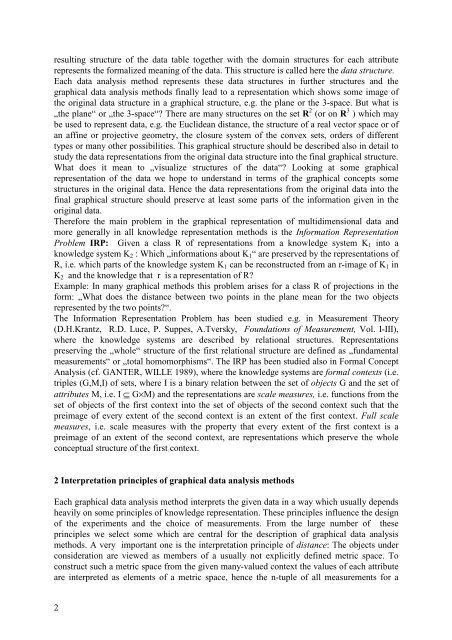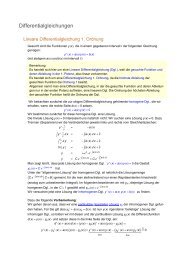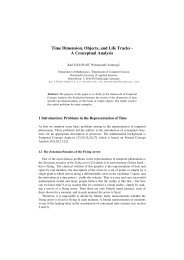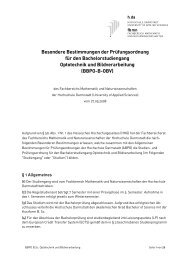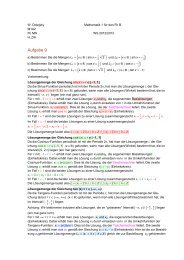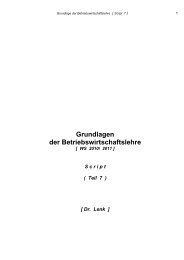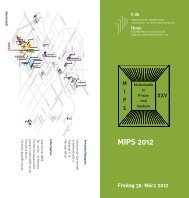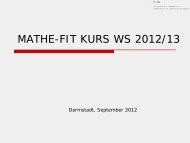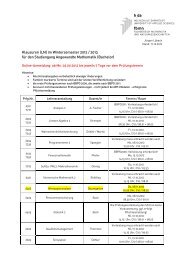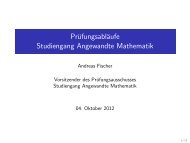comparison of graphical data analysis methods - Hochschule ...
comparison of graphical data analysis methods - Hochschule ...
comparison of graphical data analysis methods - Hochschule ...
You also want an ePaper? Increase the reach of your titles
YUMPU automatically turns print PDFs into web optimized ePapers that Google loves.
esulting structure <strong>of</strong> the <strong>data</strong> table together with the domain structures for each attribute<br />
represents the formalized meaning <strong>of</strong> the <strong>data</strong>. This structure is called here the <strong>data</strong> structure.<br />
Each <strong>data</strong> <strong>analysis</strong> method represents these <strong>data</strong> structures in further structures and the<br />
<strong>graphical</strong> <strong>data</strong> <strong>analysis</strong> <strong>methods</strong> finally lead to a representation which shows some image <strong>of</strong><br />
the original <strong>data</strong> structure in a <strong>graphical</strong> structure, e.g. the plane or the 3-space. But what is<br />
„the plane“ or „the 3-space“? There are many structures on the set R 2 (or on R 3 ) which may<br />
be used to represent <strong>data</strong>, e.g. the Euclidean distance, the structure <strong>of</strong> a real vector space or <strong>of</strong><br />
an affine or projective geometry, the closure system <strong>of</strong> the convex sets, orders <strong>of</strong> different<br />
types or many other possibilities. This <strong>graphical</strong> structure should be described also in detail to<br />
study the <strong>data</strong> representations from the original <strong>data</strong> structure into the final <strong>graphical</strong> structure.<br />
What does it mean to „visualize structures <strong>of</strong> the <strong>data</strong>“? Looking at some <strong>graphical</strong><br />
representation <strong>of</strong> the <strong>data</strong> we hope to understand in terms <strong>of</strong> the <strong>graphical</strong> concepts some<br />
structures in the original <strong>data</strong>. Hence the <strong>data</strong> representations from the original <strong>data</strong> into the<br />
final <strong>graphical</strong> structure should preserve at least some parts <strong>of</strong> the information given in the<br />
original <strong>data</strong>.<br />
Therefore the main problem in the <strong>graphical</strong> representation <strong>of</strong> multidimensional <strong>data</strong> and<br />
more generally in all knowledge representation <strong>methods</strong> is the Information Representation<br />
Problem IRP: Given a class R <strong>of</strong> representations from a knowledge system K 1 into a<br />
knowledge system K 2 : Which „informations about K 1 “ are preserved by the representations <strong>of</strong><br />
R, i.e. which parts <strong>of</strong> the knowledge system K 1 can be reconstructed from an r-image <strong>of</strong> K 1 in<br />
K 2 and the knowledge that r is a representation <strong>of</strong> R?<br />
Example: In many <strong>graphical</strong> <strong>methods</strong> this problem arises for a class R <strong>of</strong> projections in the<br />
form: „What does the distance between two points in the plane mean for the two objects<br />
represented by the two points?“.<br />
The Information Representation Problem has been studied e.g. in Measurement Theory<br />
(D.H.Krantz, R.D. Luce, P. Suppes, A.Tversky, Foundations <strong>of</strong> Measurement, Vol. I-III),<br />
where the knowledge systems are described by relational structures. Representations<br />
preserving the „whole“ structure <strong>of</strong> the first relational structure are defined as „fundamental<br />
measurements“ or „total homomorphisms“. The IRP has been studied also in Formal Concept<br />
Analysis (cf. GANTER, WILLE 1989), where the knowledge systems are formal contexts (i.e.<br />
triples (G,M,I) <strong>of</strong> sets, where I is a binary relation between the set <strong>of</strong> objects G and the set <strong>of</strong><br />
attributes M, i.e. I ⊆ G×M) and the representations are scale measures, i.e. functions from the<br />
set <strong>of</strong> objects <strong>of</strong> the first context into the set <strong>of</strong> objects <strong>of</strong> the second context such that the<br />
preimage <strong>of</strong> every extent <strong>of</strong> the second context is an extent <strong>of</strong> the first context. Full scale<br />
measures, i.e. scale measures with the property that every extent <strong>of</strong> the first context is a<br />
preimage <strong>of</strong> an extent <strong>of</strong> the second context, are representations which preserve the whole<br />
conceptual structure <strong>of</strong> the first context.<br />
2 Interpretation principles <strong>of</strong> <strong>graphical</strong> <strong>data</strong> <strong>analysis</strong> <strong>methods</strong><br />
Each <strong>graphical</strong> <strong>data</strong> <strong>analysis</strong> method interprets the given <strong>data</strong> in a way which usually depends<br />
heavily on some principles <strong>of</strong> knowledge representation. These principles influence the design<br />
<strong>of</strong> the experiments and the choice <strong>of</strong> measurements. From the large number <strong>of</strong> these<br />
principles we select some which are central for the description <strong>of</strong> <strong>graphical</strong> <strong>data</strong> <strong>analysis</strong><br />
<strong>methods</strong>. A very important one is the interpretation principle <strong>of</strong> distance: The objects under<br />
consideration are viewed as members <strong>of</strong> a usually not explicitly defined metric space. To<br />
construct such a metric space from the given many-valued context the values <strong>of</strong> each attribute<br />
are interpreted as elements <strong>of</strong> a metric space, hence the n-tuple <strong>of</strong> all measurements for a<br />
2


